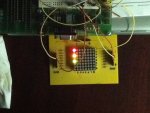trevorboultwood
Member
This is a very simple question and normally I try to give a really detailed question. This might be a little brief but hopefully every one understands. You might know that I am in the process of just having a little picture on an LED matrix. I received them this morning and it worked! But this time the problem made me laugh :L. When I was flicking through the 24 pins (that's odd shouldn't there be only 16?) I realised I was getting green and red. In a sense this is good because it forces me to use both of the colour which I am more than happy to do! OK now I have a really good diagram and a little information about bi-colour led matrix's but one slight problem! Which pin is 1 and which is 13 ? The document says there should be an indicator but there isn't! :L Hopefully some one can help thank you 
Here is a quick video of the Matrix itself :http://www.youtube.com/watch?v=8cSt8PieOgw&feature=youtu.be
:http://www.youtube.com/watch?v=8cSt8PieOgw&feature=youtu.be
And if any one can see any think i can't or have bought a similar item: http://www.ebay.co.uk/itm/320726819510?ssPageName=STRK:MEWNX:IT&_trksid=p3984.m1439.l2649
Thank you all so very much and have a wonderful Christmas! (hopefully i can be kitted out with more electronic components! )
)
Here is a quick video of the Matrix itself
And if any one can see any think i can't or have bought a similar item: http://www.ebay.co.uk/itm/320726819510?ssPageName=STRK:MEWNX:IT&_trksid=p3984.m1439.l2649
Thank you all so very much and have a wonderful Christmas! (hopefully i can be kitted out with more electronic components!


